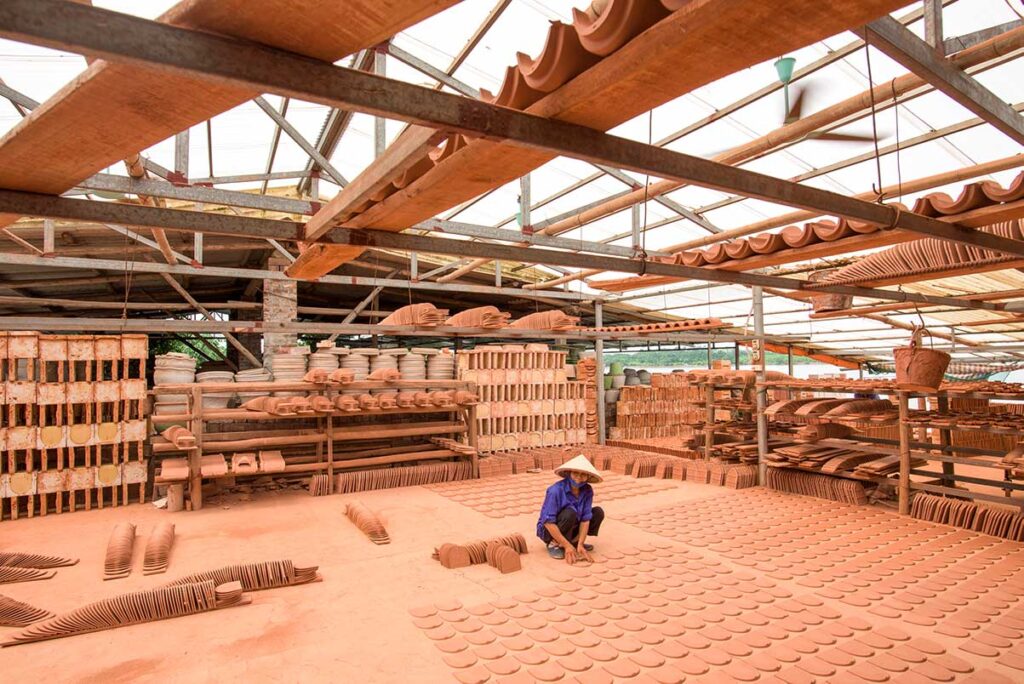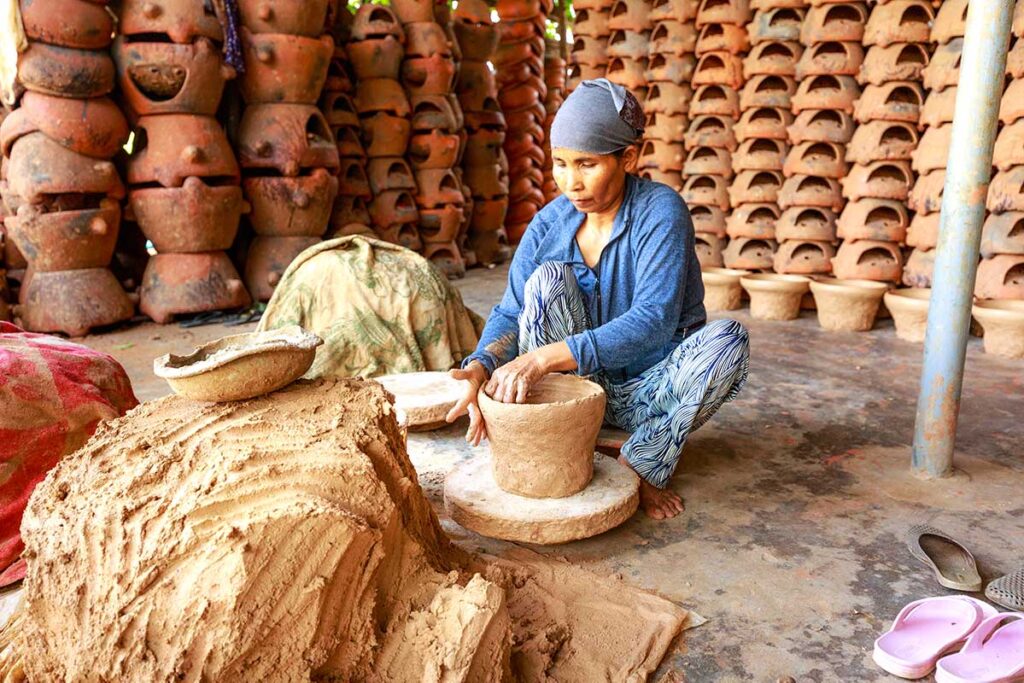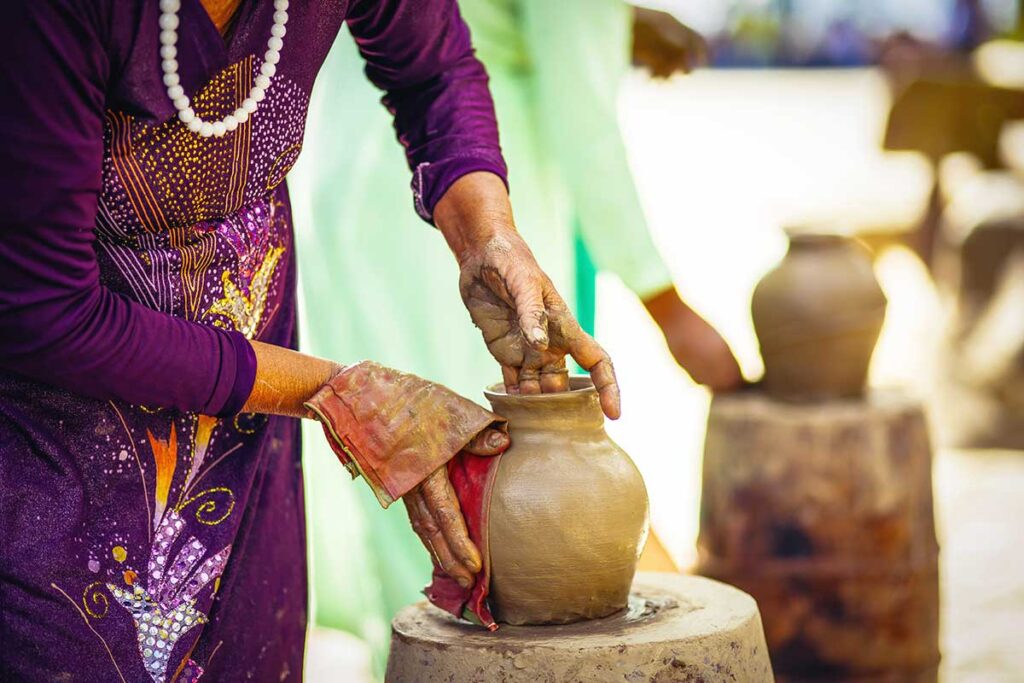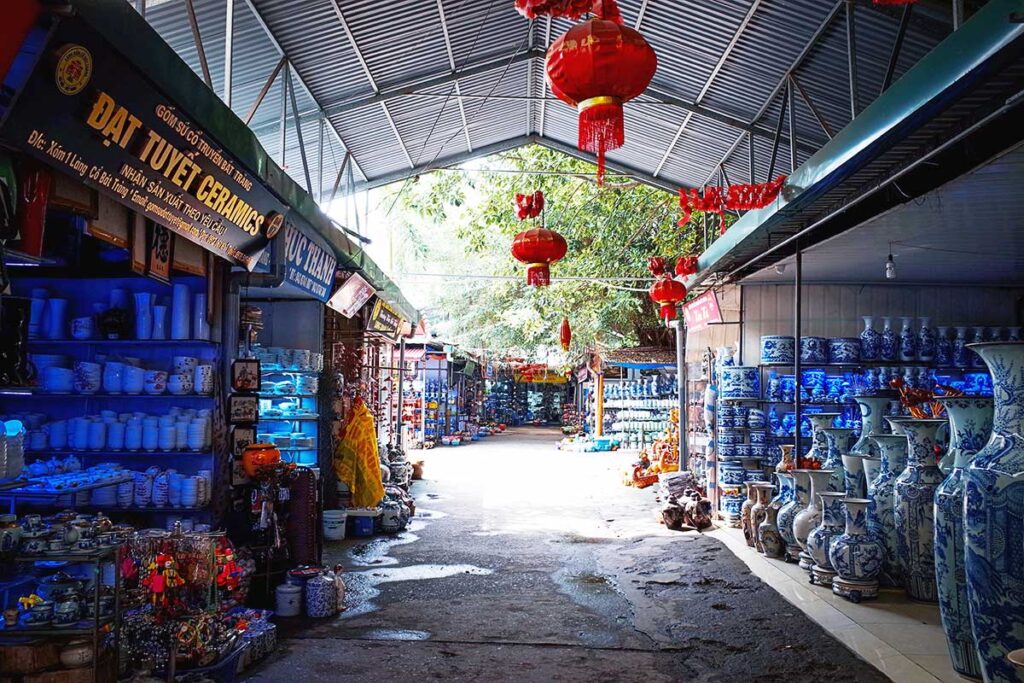Bat Trang Ceramic Village or pottery village is a popular destination for pottery enthusiasts and those interested in traditional Vietnamese crafts. It is known for its long history of producing high-quality ceramics and hand-painted pottery. Visitors can tour the village’s many workshops, learn about the production process, and even try their hand at making their own pottery.
What is Bat Trang Ceramic Village?
An introduction to Bat Trang Village
Bat Trang is one of Vietnam’s oldest and most renowned ceramic villages, with a rich history dating back over 700 years. It is renowned for its high-quality ceramics and pottery, which are highly sought after both domestically and internationally. The village’s name, which translates to “Ceramic Dock,” reflects its strategic location on the banks of the Red River, which facilitated the transportation of clay and finished products. Today, Bat Trang remains a thriving center of ceramic production, attracting both domestic and international visitors eager to witness the village’s unique artistic heritage.

History of the village
Bat Trang Ceramic Village is one of the oldest and most famous ceramic villages in Vietnam, with a history that can be traced back to the 14th century. According to historical records, the village was established in the 15th century during the reign of King Le Thanh Tong (1442-1497). It is said that the village’s first potters were skilled artisans from the neighboring Thanh Hoa province who were brought to the area to produce ceramics for the royal court.
Over time, the village’s pottery products became known for their high quality and were in demand throughout the region. During the 17th and 18th centuries, Bat Trang ceramics were exported to other countries, including Japan, the Netherlands, and Portugal, and the village became a center for ceramic production in Southeast Asia. Today, Bat Trang Ceramic Village remains an important center for Vietnamese pottery production, with many families continuing to practice traditional techniques handed down from generation to generation.
Highlights
1. Visit the ceramics workshops and galleries

Bat Trang Ceramic Village is home to numerous workshops and galleries where visitors can observe the process of making ceramic products. You can watch the artisans at work as they create intricate pieces using traditional techniques that have been passed down for generations.
Watching the artisans work with such skill and precision is a truly unique experience and offers a glimpse into the village’s rich cultural heritage.
2. Participate in a ceramic-making workshop

Participating in a ceramic-making workshop is a great experience:
- Hands-on experience: You will get to work with clay and try your hand at making pottery under the guidance of a skilled artisan.
- Learn new skills: You will learn the techniques used by local artisans to create their ceramic masterpieces, including throwing, molding, and decorating.
- Create your own masterpiece: With the guidance of the artisans, you can create your own ceramic piece, such as a cup, bowl, or vase. You can even personalize your creation with your own design or pattern.
- Take home a souvenir: Once your creation is complete, you can take it home as a unique souvenir of your visit to Bat Trang.
- Fun for all ages: Participating in a workshop is a fun and educational experience for visitors of all ages, making it a great activity for families, couples, and solo travelers alike.
3. Shop for souvenir

The village is a great place to shop for souvenirs and ceramic products. There are numerous shops and galleries selling a wide range of ceramic products, from small trinkets and decorative pieces to large vases and other practical items. Many of the shops allow visitors to watch the ceramic-making process and offer workshops where you can create your own ceramic piece. The prices are generally reasonable, and bargaining is often expected. It’s a great place to find unique and handmade gifts or Vietnam souvenirs to take back home.
4. Enjoy local Vietnamese cuisine
Bat Trang is also known for its delicious local Vietnamese cuisine, particularly its savory rice noodle soup (bun ca) and fish ball noodle soup (bun ca ngu). There are several local eateries and food stalls in the village where visitors can sample these dishes and other Vietnamese delicacies. Some restaurants even offer cooking classes, where you can learn how to prepare and cook traditional Vietnamese dishes using local ingredients.
5. Strolling around the village’s narrow streets

Strolling around the narrow streets of Bat Trang village is a unique experience. The village is quite old, dating back over 700 years, and has a rich cultural and architectural heritage. The streets are lined with traditional houses and workshops, and you can see the locals going about their daily routines. The village has a rustic charm that is perfect for a relaxing stroll, and you can also take in the beautiful scenery of the surrounding countryside. Overall, it’s a great way to immerse yourself in the local culture and get a feel for the traditional way of life in Vietnam.
6. Visit the Bat Trang Pottery Museum

For those interested in the history and evolution of Bat Trang ceramics, a visit to the Bat Trang Pottery Museum is a must.

The museum features a comprehensive collection of ceramic artifacts, showcasing the village’s rich heritage and the development of its pottery techniques over the centuries. Interactive exhibits and detailed explanations provide valuable insights into the cultural significance of ceramics in Vietnamese history.
Visiting Bat Trang Ceramic Village
Opening hours
Most shops and workshops in the village are open daily from 8:00 AM to 7:00 PM, although some may close earlier on weekends or public holidays.
Entrance fees
There is no entrance fee to enter the village, but some workshops may charge a small fee if you want to participate in a ceramic-making workshop.
Dress code
There is no specific dress code, but it is recommended to wear comfortable clothing and shoes as you will be walking around the village and potentially participating in a workshop.
Visiting tips
- The village can get crowded during weekends and public holidays, so it is recommended to visit on a weekday if possible.
- Bargaining is common when buying souvenirs or ceramics, so be prepared to negotiate a price.
- It is recommended to bring cash as some shops and workshops may not accept credit cards.
- Be mindful when walking around the narrow streets and alleys, as there may be uneven surfaces and obstacles.
- If you want to participate in a ceramic-making workshop, it is recommended to book in advance to ensure availability.
How to get there
Bat Trang Ceramic Village is located about 13 kilometers southeast of Hanoi Old Quarter. There are a few ways to get there:
By taxi or private car
You can easily hire a taxi or private car from Hanoi to take you to the village. The ride takes about 30-45 minutes, depending on traffic. The cost may vary, but it’s typically around 200,000-300,000 VND ($8-13 USD) one way.
Tour option
Tours are a convenient option if you want to avoid the hassle of transportation and learn more about the village’s history and culture from a guide.
By public bus
You can take bus number 47 from Long Bien bus station to Bat Trang. The bus ride takes about 1 hour and costs around 10,000 VND (less than $1 USD). From the bus stop, it’s about a 10-minute walk to the village.
Other craft villages around Hanoi
Hanoi is surrounded by fascinating craft villages. Visit Quang Phu Cau Incense Village for colorful incense displays, Van Phuc Silk Village for high-quality silk, and Duong Lam Ancient Village for a glimpse into the past. Also explore Le Mat Snake Village, Chang Son Hand Fan Village, Chuong Conical Hat Village, and Quat Dong Embroidery Village for unique Vietnamese crafts.







